Ah, a fresh new day in Bukhara, Day 8. We were also told that today was the start of their “Silk & Spice Festival”, which is a 3-day long local festival, therefore places might be a little more crowded than we’d been used to.
We walked to the bus, on which we headed for the Bakhaouddin Naqshbandi Memorial Complex (also called Bahoutdin Architectural Complex), just on the outskirts of Bukhara.
Khoja Bakhouddin Naqshbandi was a fourteenth century muslim theologist, a teacher to Amir Temur, and most importantly known as the founder of the Sufi order or practice. Sufism is an Islamic mysticism that teaches meditation, ritual prayer, and encourages modesty and rejection of luxury.

Once again, one of the most amazing court-yards we’ve seen is within this complex (yes, Tim is fascinated with court yards… the clean beautiful trees, the shaded “porch”/terraces, the overall tranquility)



And there is always a minaret…

But again, this was a memorial complex, so not only was there a mausoleum, there were also many mini mausoleums/tombs/grave-sites being honored within the complex:



We next headed for Sitorai Mokhi Khosa, the residences of the Bukharian emirs. (An emir is a title of a leader / aristocrat / monarch, akin to Prince or King. The Emir of a region or area was the absolute ruler of that area.) This too was a compound or complex, with many walkways, gardens, and buildings.
The primary residence is below, with what Tim thought was a very sub-par and boring court yard with no trees, just a simple, undecorated water-fountain-thingy (now that we know how much he enjoys his court-yards):


The entrance, just off to the left in the picture above, was guarded by a pair of lions, on either side of the door. Interestingly, it was forbidden for artists to make actual representations of living animals, so they were given exaggerated features (which is why often statuary looks odd and not life like at all).


The inside halls and rooms were quite ornate, as one would expect of an Emir’s residence:


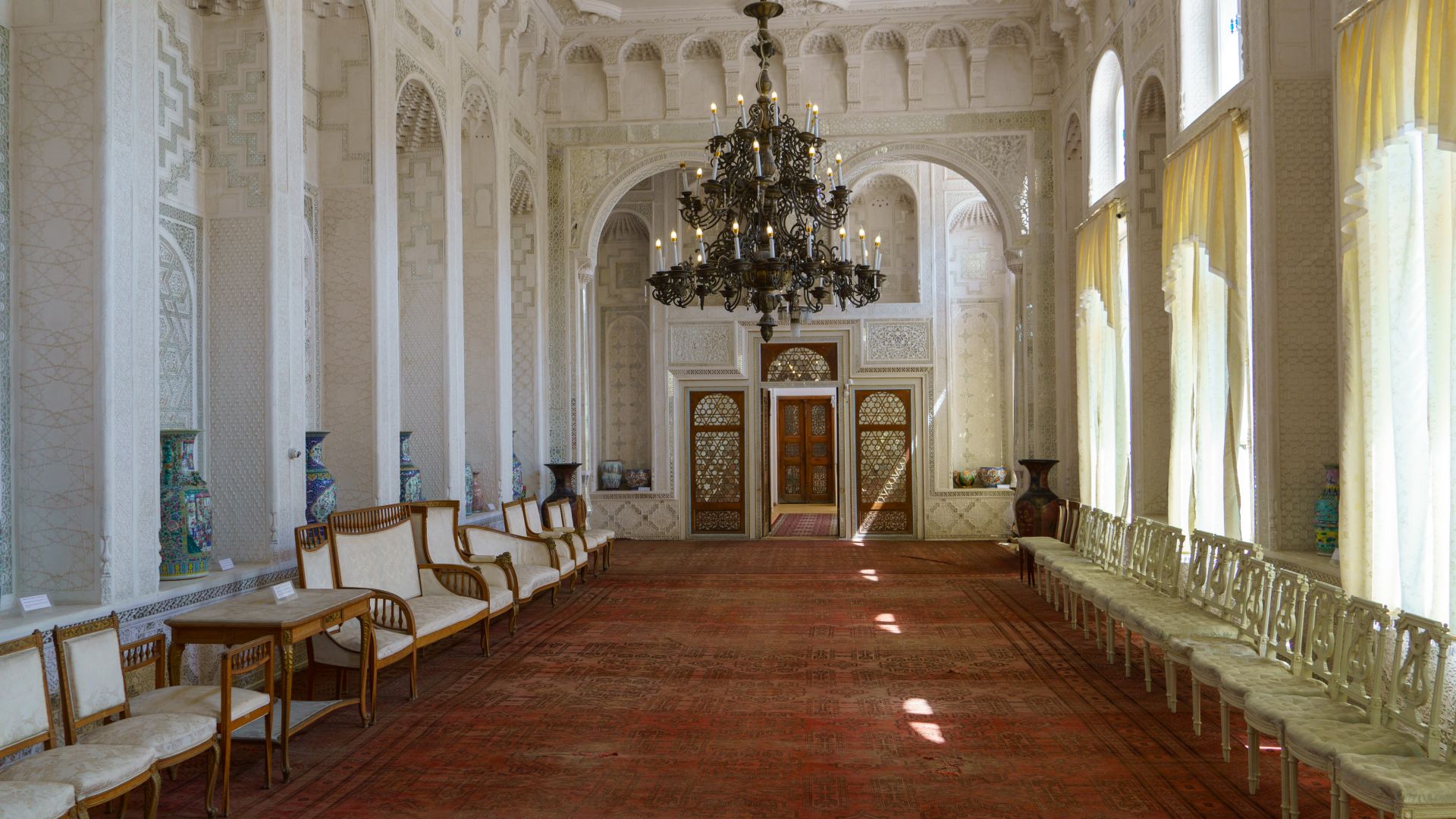
For those who might recognize it from previous trips, below is a ceramic heater utilized to heat the rooms.
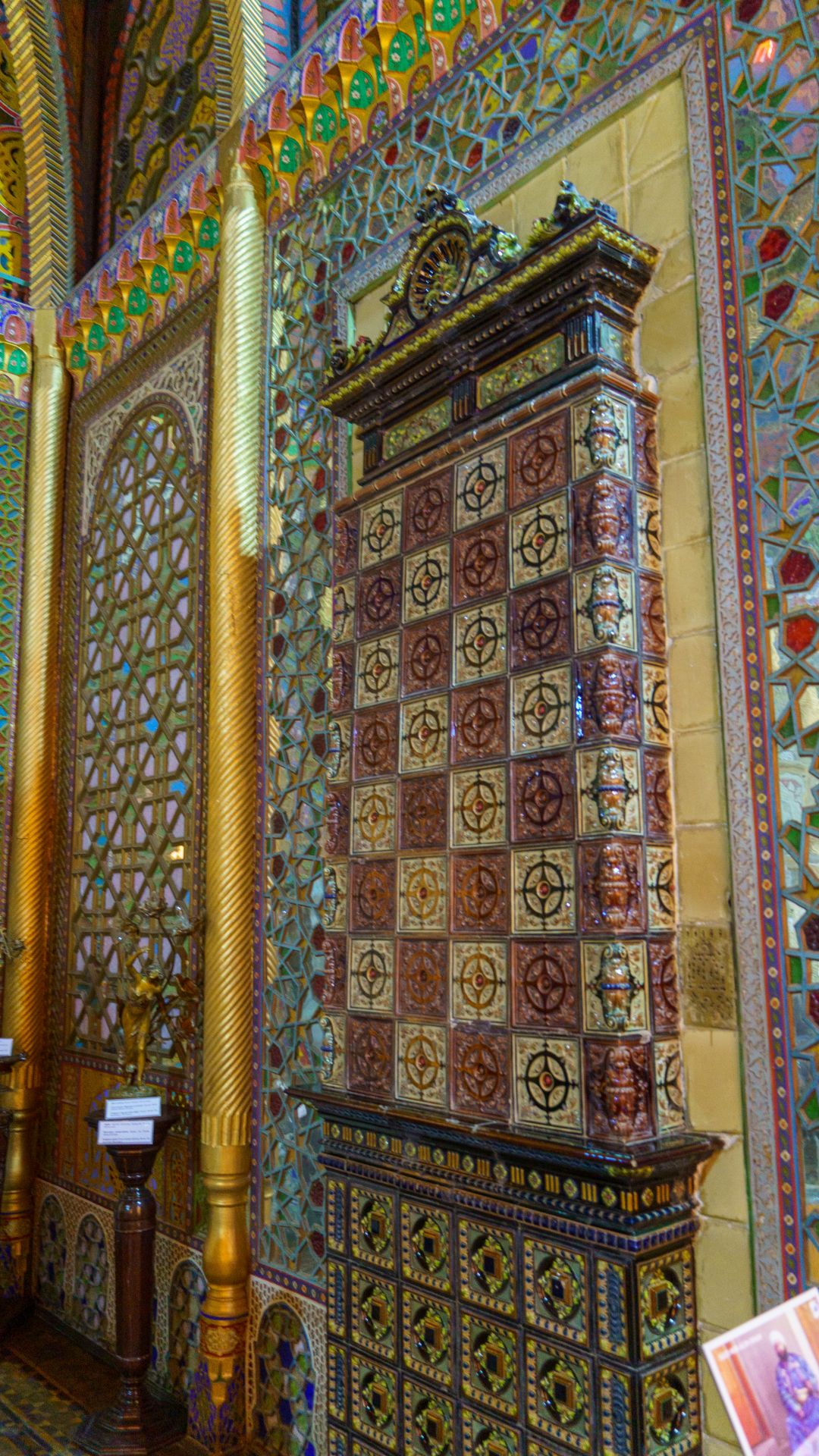

One of the things that rulers typically had to represent and show off their wealth (we’ve seen it at many palaces in many countries), were peacocks roaming the grounds. This complex did not disappoint, with several peacocks having free reign over the grounds as they pleased.
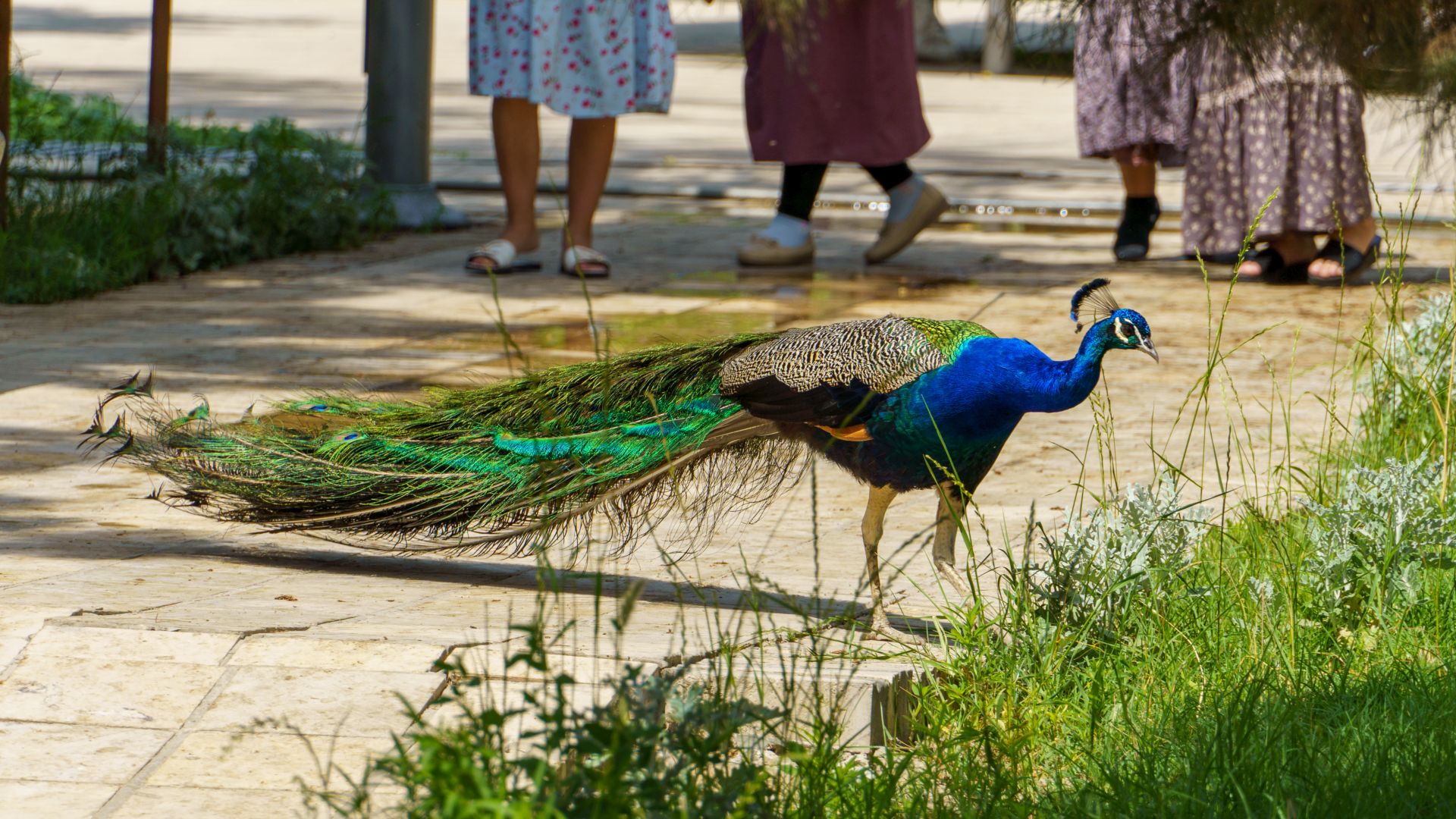
Another interesting feature was the iron work covering some of the pathways had wine vines as the growing / shade medium. We postulated that perhaps this provided grapes to make wine with, as they did not appear to be the type we are used to seeing for eating (i.e. larger table style grapes).

We did note that it seemed fairly crowded due to the Silk and Spice festival, and the overall complex was in particular over-run mostly with school children groups (age 12-16 range). One group after another just seemed to be everywhere, although despite them being typical children (a little noisy and rambunctious), they honestly were well behaved compared to what we might see in the states.
Finally in addition to showing this complex’s minaret, we found it quite interesting that the mosque / area for prayer, only for the Emir of course, was right with the minaret.

We left Sitorai Mokhi Khosa for one last stop before lunch, which was the Chor Minor Madrasah.
For this stop, the bus dropped us off and then we had to walk through a series of alleyways (no, they were really roads, but to us they look and feel like alleys). While we would walk down the middle of them, occasionally a car would come, and you had to cram up against a wall to let it by.
To give you a feel for these old roadways (alleyways), here are some pictures taken when a car was coming:

Below, the car after passing us was coming to the next intersection, when another car wanted to come down our road as well. Wellllll, there’s not room for 2-way traffic, so he had to back up and let the 1st car exit first.

We are super glad we don’t have to drive around here, and we better understood why the bus just dropped us off and made us walk as well.
We’re not sure why, although Tim speculated perhaps they were entrances to the basements or sub-levels, but there were quite a few “short” doors as well. (Not all of them, but more than a couple, which made it stand out.)
To give you a feel for how short, here’s Jay with one for scale:

Finally, from the picture above you can get a feel for the general construction in Bukhara (and Khiva before that).
Most buildings seem to be constructed of a clay brick / clay block, that once laid is then sealed over with a coating of clay and straw as a sealer. You can see the straw sticking out by Jay in the picture above, but we also came across a wall being freshly patched (we assume routine maintenance) which really helps bring home the construction type.


Anyway, after walking through the maze-ish residential area, we finally came to the ancient madrasah.

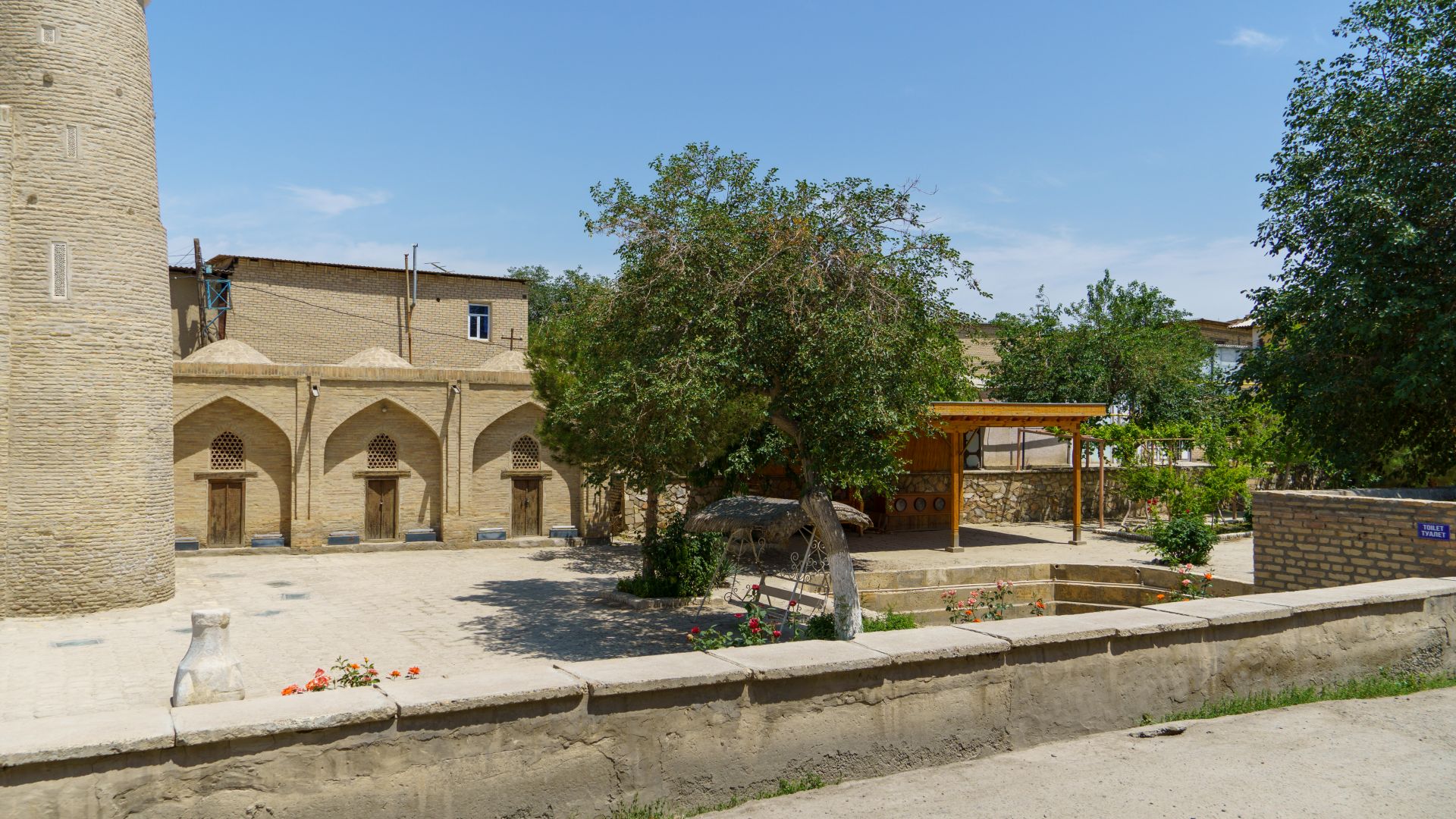
Notice the stork’s nest atop one of the towers? This was evidently fairly common, and a sign of good luck / good blessings to have storks and stork’s nests on your structure. (These of course were not real, but put up there for the historical reference.) We had seen several old photos of towers showing stork’s nests on all of the towers, back in the day.

After a lunch at a very nice, new, upscale restaurant we continued the day’s journey to see a pair of mausoleums. The mausoleum of Ismail Samani and the Chashmayi Ayyub mausoleum.
Imagine our surprise when the bus pulled up to an amusement park to let us off. Unsure what was going on, we thought “hey, let’s go ride a ride” until our guide told us the mausoleums were on the other side of the park and we’d have to walk through the amusement park to get to them.
(Okay, we really didn’t contemplate for even a second riding any rides. One of the first comments Jay made as she got off of the bus was, “Wow, they couldn’t get away with that in the states”, while looking at apparent safety violations on a few of the rides.)
The mausoleum of Ismail Samani sat within a very attractive park-like atmosphere.

And while not crazy ornate with blue tile or gold bedazzling everywhere, was super cool in just the architectural way that the brick/block work was put together in constructing the building.
Here’s a quick peek from the inside on the intricate patterns the brick work of the walls and window areas were laid.


Chashmayi Ayyub mausoleum was a little bit of a walk from here, and as we were walking… the weather changed.
Us Midwesterners (okay, all of us, Americans and Canadians alike) looked at the sky and said “Look at the clouds coming in, I wonder if we’ll have to be running back through the rain.”
We didn’t wonder this for too long, between our guide starting to tell us how storms off of the desert creates dust storms, and the arrival of the dust storm mid explanation, we quickly got the gist of what was going to happen. (Admittedly it was a very minor “dust-up” compared to what they can sometimes get.)
We grabbed a few pictures that don’t truly do justice for what it was like. There were several folks, Tim included, that breathed in grit, that no amount of coughing (or water) could seem to dislodge. It felt like your throat had been scratched, and the irritation wasn’t physically there any longer, it was the scratch itself. Thankfully everyone still had Covid 19 masks on them (for just-in-case), so we all masked up which helped.



And no, none of the pictures above were taken with a “sepia” filter… they are all full-on color photographs, that’s just the dust storm. (You can start to see it accumulating on the ground a little in the bottom photo.)
The mausoleum honoring the prophet Job, actually felt more like a museum, a water museum to be precise, as it was mainly informational / educational displays on water in the region, how they stored water in the past, where they get water from, etc.
Sadly, much of their water is drying up and disappearing. (I guess that is why they are in a desert.) Here is a display on the Aral sea, which shows how in the last 60 years it has almost dried up and disappeared.

After we trekked back to and through the amusement park to get to the bus, we discovered that they’d been hit pretty hard as well. Winds had blown hard enough in the dust storm, that a tree by our bus had blown over / came down (luckily not on our bus or any of the cars), but still…

Grit covered and grimy, we headed back to the hotel to clean up and rest before dinner.
Excitingly, we were having dinner in a 19th century, Jewish residence. Originally we were to be on the front porch, but due to weather we were actually in the home. It did not let us down, as it was very impressive, ornate, and… well impressive.

(Above is where we were originally supposed to eat… below is the room we ended up in.)

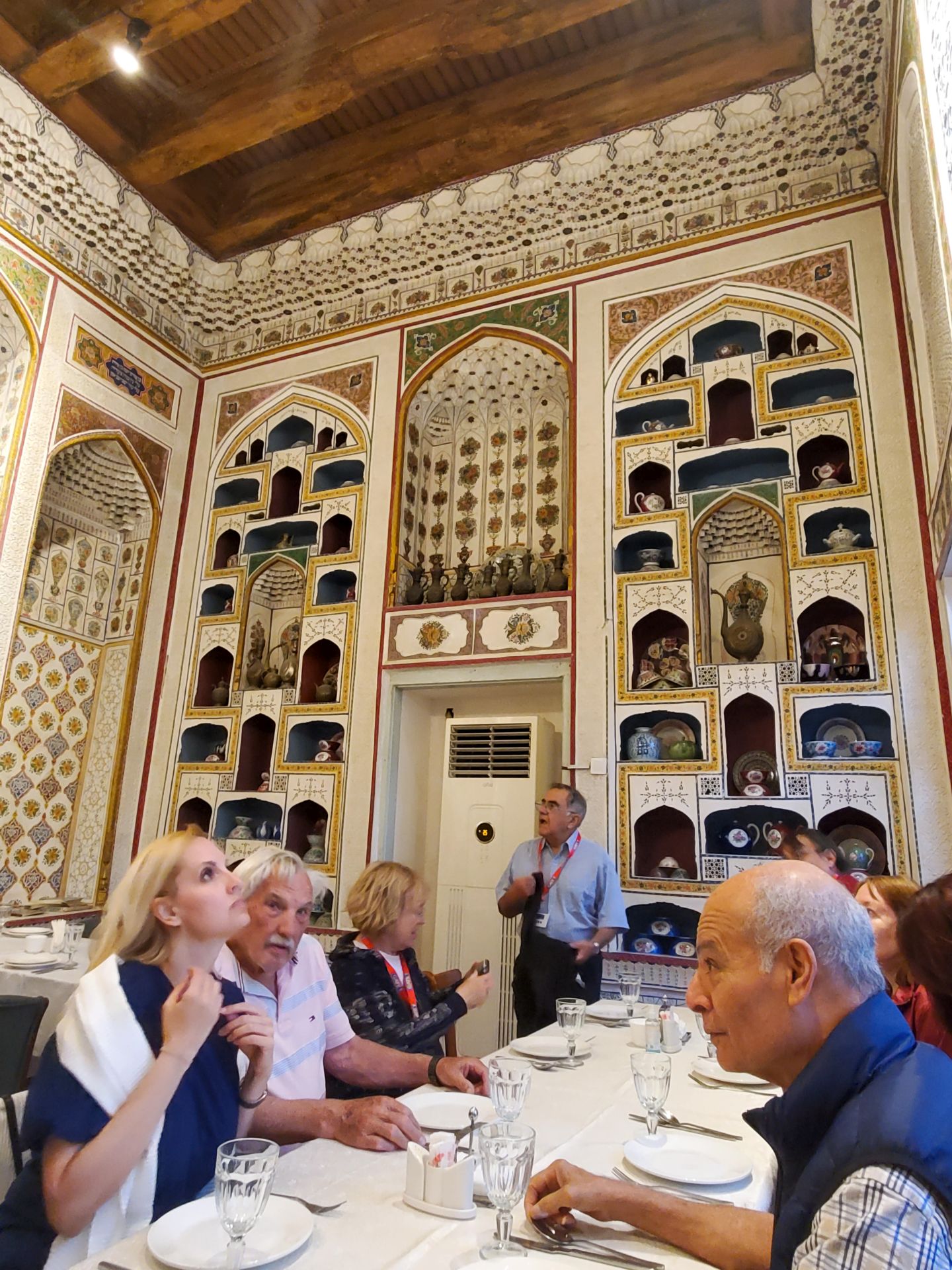

Well, that’s it for today. We’ll see you tomorrow.

Leave a reply